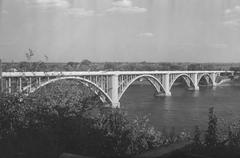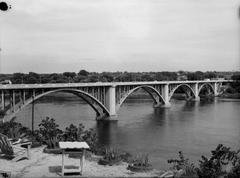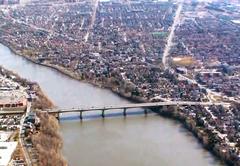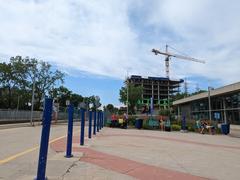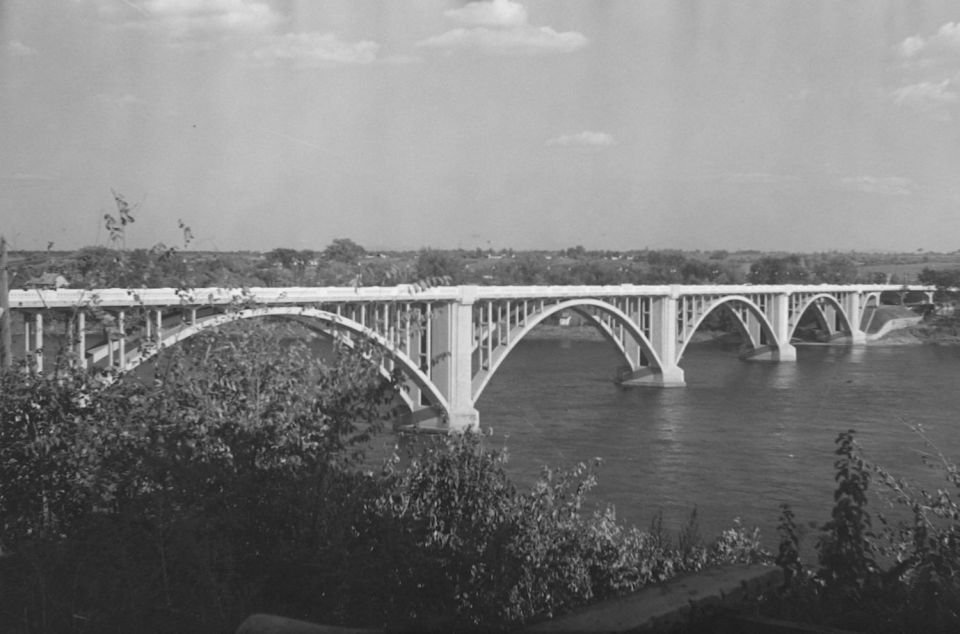
Pie-IX Bridge Visiting Hours, Tickets, and Travel Guide: Laval Historical Sites
Date: 14/06/2025
Introduction: The Pie-IX Bridge’s Significance
The Pie-IX Bridge is a key infrastructural and cultural landmark connecting Montreal and Laval across the Rivière des Prairies. Serving as a critical artery for urban mobility, freight logistics, and community integration, the bridge is much more than a crossing—it is a testament to Montreal’s industrial heritage, innovative engineering, and sustainable urban development. The bridge’s ongoing rehabilitation and expansion (2023–2025) highlights Montreal’s commitment to connectivity and environmental sustainability, with upgrades including foundation restoration, new rail tracks, and advanced active transportation infrastructure (Renew Canada; CIMA+).
With accessible pedestrian and cycling pathways linking Montreal and Laval’s networks, scenic views, and a modernized multimodal transit corridor, the Pie-IX Bridge stands out as a must-see for history buffs, urban explorers, and commuters alike.
Contents Overview
- Historical Development of the Pie-IX Bridge
- Visiting Information: Hours, Accessibility, and Attractions
- 2024–2025 Rehabilitation and Expansion Project
- Structural, Economic, and Cultural Impact
- Future Developments: Blue Line Metro Extension
- Visitor Tips and Practical Information
- Community Engagement and Urban Renewal
- Frequently Asked Questions (FAQ)
- Visuals and Media
- Conclusion and Recommendations
Historical Development of the Pie-IX Bridge
Early Context: Montreal and Laval’s Bridges
Montreal’s island geography has demanded innovative bridge construction since the 19th century. The Pie-IX Bridge, named after Pope Pius IX, consists of a vehicular road bridge and a parallel railway bridge, both crucial to the city’s freight and commuter networks. The original railway bridge served industrial needs, supporting key sectors like the Lantic sugar refinery and the Port of Montreal.
Construction and Evolution
Initially built to accommodate both freight and vehicular traffic, the Pie-IX bridges have been periodically upgraded to handle heavier loads and increased traffic. The modern Pie-IX corridor supports not only vehicles but also pedestrians, cyclists, and public transit, reflecting the city’s evolving transportation needs.
Visiting the Pie-IX Bridge: Hours, Access, and Attractions
Can You Visit the Pie-IX Bridge?
- Road Bridge: Open to vehicles, pedestrians, and cyclists 24/7. Dedicated walking and cycling lanes provide safe, scenic passage.
- Railway Bridge: Not open for public access due to operational requirements, but easily viewed from parks and riverfront paths.
Visiting Hours and Tickets
- Bridge Access: Free and open at all hours to pedestrians, cyclists, and vehicles.
- No Tickets Required: There are no entrance fees.
- Amenities: Certain adjoining parks or community gardens may have specific opening hours—check local signage or municipal websites.
Tours and Viewing Opportunities
There are no official guided tours, but numerous vantage points offer excellent views and photographic opportunities, especially at sunset. The bridge’s belvederes (viewpoints) on both sides provide panoramic sights of the river and city skyline.
Nearby Attractions
- Montréal-Nord Parks: Riverbank green spaces for walking and relaxation.
- Montreal Botanical Garden: A short trip from the bridge, offering renowned horticultural displays.
- Laval Nature Parks: Trails and waterfront views.
- Historic Old Montreal: Easily accessed via public transit for a deeper dive into the city’s past.
2024–2025 Rehabilitation and Expansion Project
Project Overview
A $42.41 million rehabilitation initiative is modernizing the Pie-IX railway bridge, including:
- Foundation and deck restoration
- Addition of a fourth rail track
- New rail storage tracks for industrial clients
- Improved supply chain efficiency and environmental performance
The project is partly funded by a $16.75 million federal investment and managed by Pomerleau (Renew Canada).
Engineering Highlights
- Structural reinforcement with caisson piles and retaining walls
- Use of sustainable materials, including recycled glass powder in concrete
- Seismic upgrades and modern lighting for safety
Structural, Economic, and Cultural Impact
Strategic Transportation Link
The bridge supports tens of thousands of daily crossings, maintaining Montreal’s role as a major trade hub. The integration of new rail and bus rapid transit infrastructure reduces traffic congestion, encourages active transportation, and supports regional economic growth (Port of Montreal).
Community and Cultural Connector
By linking neighborhoods and fostering cultural exchange, the Pie-IX Bridge has become a symbol of urban integration. The addition of public art, such as the “Kyrielle” installation on BRT shelters, celebrates the city’s diversity and creativity (MTL Blog).
Future Developments: Blue Line Metro Extension
Significant transit enhancements are underway, with the Blue Line metro extension and new Pie-IX station scheduled for completion by 2031. These upgrades will include:
- Two station entrances
- Integrated bus terminal
- Direct pedestrian tunnel to the Pie-IX BRT
- Improved accessibility and multimodal connections
During construction, archaeological findings have added to the area’s historical narrative (MTL Blog).
Accessibility and Multimodal Transport Options
Active Transportation
- Cyclists and Pedestrians: Dedicated, physically separated cycling lanes and wide sidewalks ensure safety and comfort for all users. Belvederes provide rest spots and views (Québec.ca).
- Universal Access: Ramps, tactile paving, and gentle slopes accommodate strollers, wheelchairs, and walkers.
Public Transit and Vehicular Flow
- Pie-IX BRT: Reserved bus lanes with frequent service connect to metro and regional bus lines, improving transit speed and reliability.
- Vehicular Access: Multiple lanes, modern deck and guardrail construction, and upgraded ramps to major boulevards ensure smooth traffic flow (CIMA+).
Visitor Amenities and Facilities
- Belvederes: Scenic viewpoints for relaxation and photography.
- Community Spaces: Gardens and landscaped cycling paths enhance the urban experience.
- Safety: Robust barriers, slip-resistant surfaces, and modern lighting ensure a secure passage.
- Wayfinding: Clear signage and informational panels provide historical context and practical guidance.
Practical Tips for Visitors
- Plan your trip: Use Québec 511 or STM for real-time updates.
- Active transport: Walking or cycling is encouraged, especially during off-peak hours.
- Weather: Dress for conditions; the bridge is maintained year-round but exposed to the elements.
- Accessibility: All pathways are designed for universal access.
- Photography: Best times are early morning or sunset at the belvederes.
Community Engagement and Urban Renewal
Extensive consultations have shaped the bridge’s redesign, addressing safety, noise, and environmental factors. The revitalization of the Pie-IX corridor promotes economic activity, community pride, and urban renewal (CIMA+).
Frequently Asked Questions (FAQ)
Q: What are the Pie-IX Bridge visiting hours?
A: Open 24/7 to pedestrians, cyclists, and vehicles.
Q: Are tickets or fees required?
A: No, access is free for all users.
Q: Is the bridge accessible for people with disabilities?
A: Yes, with ramps, tactile paving, and wide sidewalks.
Q: Are guided tours available?
A: No official tours, but local cycling and walking groups include the bridge in their routes.
Q: What public transit options are available?
A: The Pie-IX BRT connects to metro and commuter trains, with frequent service.
Q: What are the best times for photography?
A: Early morning, late afternoon, and sunset.
Visuals and Media
Conclusion and Visitor Recommendations
The Pie-IX Bridge is more than infrastructure—it is a living connection between Montreal and Laval, supporting economic growth, cultural exchange, and sustainable urban mobility. With its modernized pathways, integrated public transit, and vibrant community spaces, it invites both daily commuters and visitors to experience Montreal’s evolving urban landscape. Stay informed about construction and transit updates to make the most of your visit. To deepen your experience, download the Audiala app and follow official sources for real-time guides and alerts.
Sources and Further Reading
- Renew Canada: Pie-IX Railway Bridge Project
- CIMA+: Major Repairs to the Pie-IX Bridge
- Québec.ca: Pie-IX Bridge Rehabilitation
- MTL Blog: Montreal’s New Pie-IX Rapid Transit Route
- Port of Montreal: Bridge Pie-IX
- On-Site Magazine: Federal Funding for Pie-IX Bridge
